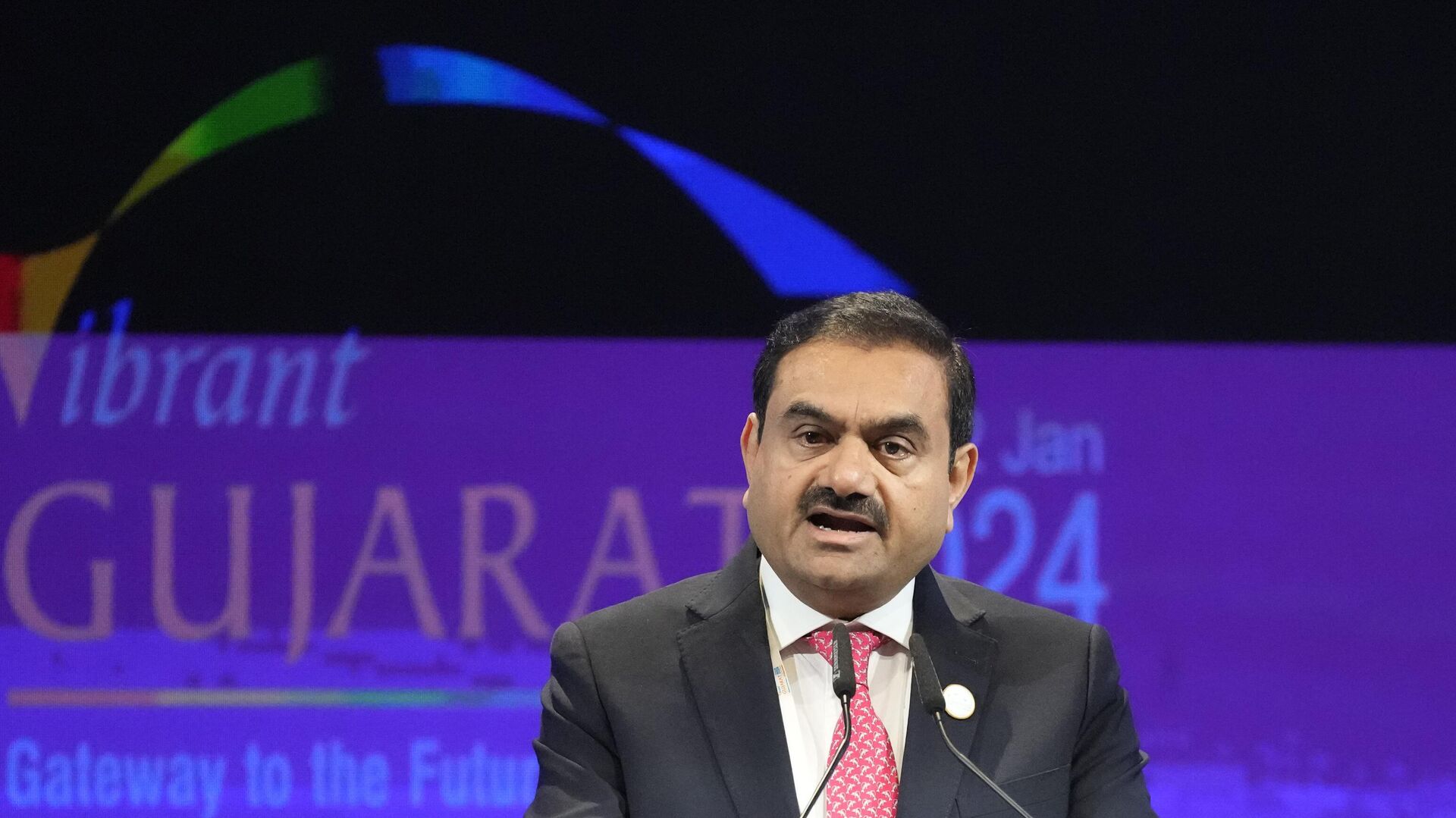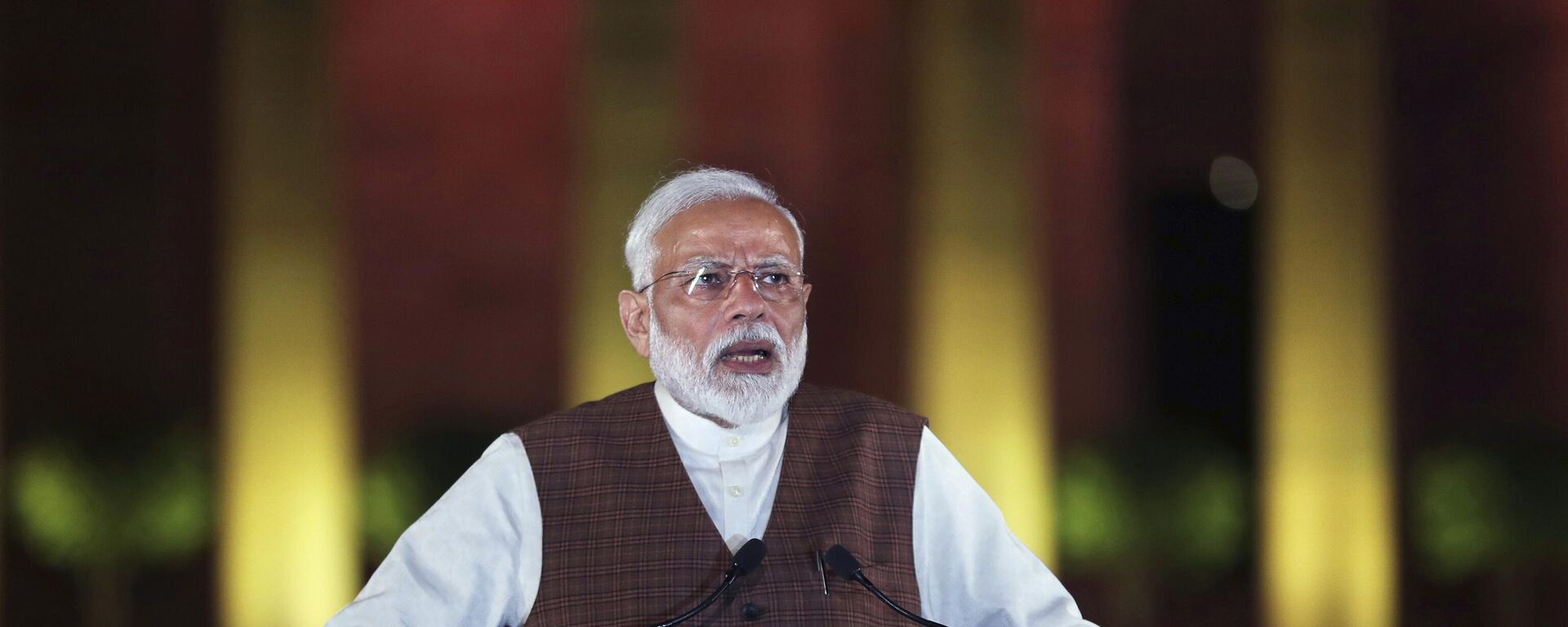https://sputniknews.in/20240829/indian-economy-to-surpass-us-in-25-years-adani-group-8078395.html
Indian Economy to Surpass US in 25 Years: Adani Group
Indian Economy to Surpass US in 25 Years: Adani Group
Sputnik India
India finds itself at a critical historical juncture, slated to expand its economy (nominal GDP) to the size of the American economy in the next 25 years, Adani Enterprises Group Chief Financial Officer (CFO) said
2024-08-29T16:45+0530
2024-08-29T16:45+0530
2024-08-30T00:16+0530
business & economy
gautam adani
narendra modi
india
us
new delhi
gdp
brics
brics expansion
g7
https://cdn1.img.sputniknews.in/img/07e8/02/08/6484419_0:154:3095:1894_1920x0_80_0_0_234d9bc1abf052b962de18157993d84b.jpg
India finds itself at a critical historical juncture, slated to expand its economy (nominal GDP) to the size of the American economy in the next 25 years, Adani Enterprises Group Chief Financial Officer (CFO) Jugeshinder 'Robbie' Singh told a press conference in Ahmedabad on Thursday.The briefing was organised to announce the launch of Adani Enterprises maiden public issuance of secured, rated, listed redeemable, non-convertible debenture (NCD), which is aimed at raising debt from the world's fastest-growing major economy.Singh remarked that the current Indian generation had a big responsibility on its shoulders.According to official statistics, India's nominal GDP in Financial Year 2023-24 stood at around $3.5 trillion, making it the fifth largest economy in the world. On the other hand, the US nominal GDP in the same year stood at $28.78 trillion.Earlier, Prime Minister Narendra Modi has expressed confidence that India would become the world's third biggest economy by 2030, lagging only the US and China.Meanwhile, the Indian Economic Survey 2023-24, released in July, spells out a plan geared towards maintaining an annual GDP growth of 6-8% in the next 25 years and continuing the "structural transformation" championed by the Modi government.The Survey lists the strengthening of the Micro, Small and Medium Enterprises (MSMEs) sector as another major objective, noting that it contributes approximately 30% of the country’s GDP, 45% of manufacturing output and provides employment to over 110 million Indians.Further, enhancing physical and digital connectivity, increasing the share of Indian exports in manufacturing and "removing bottlenecks" in the agriculture sector, which is the largest employer in India, are some of the other economic objectives spelled out by the Indian government to become a developed nation by 2047.India has Emerged as a Shining Star: AcademicAshwani Mahajan, a Delhi University (DU) professor and the co-convenor of economic advocacy group Swadeshi Jagran Manch (SJM), told Sputnik India that he “fully subscribed” to the view that Indian economy would surpass that of the US in coming years.The Indian economic expert remarked that optimism around India’s medium and long-term economic prospects was because of the growth-oriented policy outlook of the government as well as the work being done at the ground level.“In terms of digital technology, our effort is to maximise the use of Unified Payments Interface (UPI) and other domestic payments platforms. India is already a global leader in digital transactions, giving it an edge over the US and other developed nations,” Mahajan explained.He noted that, in the long run, such platforms could also shield Indian companies from potential disruptions such as sanctions or getting cut off from SWIFT Network.“Our exports are becoming more competitive. At the same time, we are moving towards achieving self-reliance in manufacturing, be it in defence, telecom, mobiles, laptops or APIs,” he said.
https://sputniknews.in/20240220/india-to-become-worlds-third-largest-economy-modis-election-pitch-in-jammu-6618879.html
india
us
new delhi
china
Sputnik India
feedback.hindi@sputniknews.com
+74956456601
MIA „Rossiya Segodnya“
2024
Dhairya Maheshwari
https://cdn1.img.sputniknews.in/img/07e6/0c/13/138962_0:0:641:640_100x100_80_0_0_2cb44360dbcdf6d84bf4b299cd045917.jpg
Dhairya Maheshwari
https://cdn1.img.sputniknews.in/img/07e6/0c/13/138962_0:0:641:640_100x100_80_0_0_2cb44360dbcdf6d84bf4b299cd045917.jpg
News
en_IN
Sputnik India
feedback.hindi@sputniknews.com
+74956456601
MIA „Rossiya Segodnya“
Sputnik India
feedback.hindi@sputniknews.com
+74956456601
MIA „Rossiya Segodnya“
Dhairya Maheshwari
https://cdn1.img.sputniknews.in/img/07e6/0c/13/138962_0:0:641:640_100x100_80_0_0_2cb44360dbcdf6d84bf4b299cd045917.jpg
adani news, adani power share, indian economy, india gdp, india gdp growth, modi news, brics expansion, brics vs g7, india economic crisis, recession in west, business news, economy news
adani news, adani power share, indian economy, india gdp, india gdp growth, modi news, brics expansion, brics vs g7, india economic crisis, recession in west, business news, economy news
Indian Economy to Surpass US in 25 Years: Adani Group
16:45 29.08.2024 (Updated: 00:16 30.08.2024) India's annual GDP has grown by more than 10 times in the last 30 years, from less than $300 billion in 1993 to almost $3.6 trillion last fiscal. Under PM Modi, India has propelled to the position of the world's third biggest economy. New Delhi's economic game plan is geared towards sustaining the growth momentum till 2047.
India finds itself at a critical historical juncture, slated to expand its economy (nominal GDP) to the size of the American economy in the next 25 years, Adani Enterprises Group Chief Financial Officer (CFO) Jugeshinder 'Robbie' Singh told a press conference in Ahmedabad on Thursday.
"India will add an economy the size of the US in the next 25 years. What the US managed in 200 years, we will be doing in the next 25 years," Singh told the briefing.
The briefing was organised to announce the launch of Adani Enterprises maiden public issuance of secured, rated, listed redeemable, non-convertible debenture (NCD), which is aimed at raising debt from the world's fastest-growing major economy.
Singh remarked that the current Indian generation had a big responsibility on its shoulders.
"The future generation will look at us and say that we had the courage to look into eye and deliver... This generation won't let India come to its knees like what happened in the 1990s (balance of payments' crisis at the end of Cold War)," the Adani executive stressed.
According to official statistics, India's nominal GDP in Financial Year 2023-24 stood at around $3.5 trillion, making it the
fifth largest economy in the world. On the other hand, the US nominal GDP in the same year stood at $28.78 trillion.
Earlier, Prime Minister Narendra Modi has expressed confidence that India would become the world's third biggest economy by 2030, lagging only the US and China.
Meanwhile, the Indian Economic Survey 2023-24, released in July, spells out a plan geared towards maintaining an annual GDP growth of 6-8% in the next 25 years and continuing the "structural transformation" championed by the Modi government.
The foremost priority for India is to boost private sector investments, particularly in the manufacturing and infrastructure sectors, according to the Survey.
The Survey lists the strengthening of the Micro, Small and Medium Enterprises (MSMEs) sector as another major objective, noting that it contributes approximately 30% of the country’s GDP, 45% of manufacturing output and provides employment to over 110 million Indians.
Further, enhancing physical and digital connectivity, increasing the share of Indian exports in manufacturing and "removing bottlenecks" in the agriculture sector, which is the largest employer in India, are some of the other economic objectives spelled out by the Indian government to become a developed nation by 2047.
India has Emerged as a Shining Star: Academic
Ashwani Mahajan, a Delhi University (DU) professor and the co-convenor of economic advocacy group Swadeshi Jagran Manch (SJM), told Sputnik India that he “fully subscribed” to the view that Indian economy would surpass that of the US in coming years.
“Among all the global economies, India has emerged as a shining star in terms of GDP growth, developing infrastructure and connectivity, and attracting private sector investments,” Mahajan said.
The Indian economic expert remarked that optimism around India’s medium and long-term economic prospects was because of the growth-oriented policy outlook of the government as well as the work being done at the ground level.
Mahajan said that four main factors have contributed to resilience of the Indian economy amid geoeconomic fragmentation and headwinds—digitisation, bolstered connectivity, push towards achieving self-reliance in manufacturing (atmanirbharta) and growing trade in national currencies.
“In terms of digital technology, our effort is to maximise the use of Unified Payments Interface (UPI) and other domestic payments platforms. India is already a global leader in digital transactions, giving it an edge over the US and other developed nations,” Mahajan explained.
He noted that, in the long run, such platforms could also shield Indian companies from potential disruptions such as sanctions or getting cut off from SWIFT Network.
Spelling out the benefit government’s growing investments in infrastructure, the Indian expert said that this was driving down manufacturing costs by reducing expenses incurred on logistics.
“Our exports are becoming more competitive. At the same time, we are moving towards achieving self-reliance in manufacturing, be it in defence, telecom, mobiles, laptops or APIs,” he said.
Mahajan also lauded the ongoing push towards trading in national currencies, saying that the policy step was not only serving to shed reliance on US Dollar (USD), but also reducing import bills.



